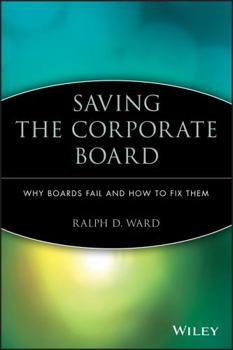Saving the Corporate Board pb
Select Format
Select Condition 
Book Overview
Ward reveals ten specific failings that are built into our boardroom model and provides real-world fixes to get boards back on track. Ward mixes tart, insightful analogies (what do boards have in... This description may be from another edition of this product.
Format:Paperback
Language:English
ISBN:1119090911
ISBN13:9781119090915
Release Date:April 2003
Publisher:Wiley
Length:244 Pages
Weight:0.73 lbs.
Dimensions:0.5" x 6.0" x 9.0"
Customer Reviews
2 ratings
Solid material for board development
Published by Thriftbooks.com User , 17 years ago
This book was released after headline-making board room issues exploded in the business news several years ago. Ward provides essentials worth our attention in our still quickly-evolving board environment. Note that the book is useful for non-profit boards also as they face increasing mandates to ensure a business-like approach to their planning and execution. Three subjects in the book were especially important to me based on my work with board development: 1) Finding talent for boards, 2) Training boards, 3) Efficiency of boards. Ward notes the need to find the specific skills needed for the board. Finding high quality board talent is, to me, going to be increasingly difficult as the generational transition occurs. I have seen boards that have not aggressively chosen and trained new blood, and so they are not training the next generation of senior leaders in organizations. In so many boards, old "names" are recruited rather than skills. It is important that a thorough analysis of organizational needs be done prior to board recruiting, then the right match be made for the knowledge, not the family name. Training is an issue I have seen gain some attention in nonprofit boards, and I hope that trend continues. Ward provides good direction on creating the foundation for training directors. Training board directors never stops and I have found that some of the best training comes not from "presentation style" materials, but providing challenging technical and market issues to the board members and devoting time for real discussion in the board and subcommittee meetings. Ward hits the points well. That leads to efficiency. Ward notes techniques such as "consent agendas" as tools to move past the routine and into fuller dialogue for boards. I'd suggest lingering on Ward's list of "syndromes" on audit committees to stimulate your thinking about the ways that old methods can stifle progress. This list has applicability across board practices. Ward also notes techniques to handle nonproductive directors. This is a terrific introduction to board room work.
Proven advice for putting boards back on track
Published by Thriftbooks.com User , 19 years ago
When we hear about the scandals in companies like American Enron, Italian Parmalat and so on, we get a little bit of insight into what (also) happens around the mahogany roundtable in the obscure boardroom. We are witness to dictatorial executives, antiquated decision processes, incompetent amateurs, and sometimes even corrupt lawbreakers. Often the focus is on the catastrophic mistakes in management, auditing, and/or disclosures. But the sad truth is that many of these mistakes could have been found and fixed in the boards. The board's role is to supervise and govern. If the board does not have the resources themselves, they must make sure that an impartial third-party service provider does it. This book explores why corporate boards fail and also give ideas on how to fix them. The author reveals ten specific failings of the typical boardroom model and proven advice to get boards back on track. Some of the boardroom ills he diagnoses include: WEAK BOARD LEADERSHIP Problem: The board oversees (at the same time it is led by) the CEO. Too many boards accept that the CEO runs the board meetings - without being sufficiently challenged by the chairman or the others. In Europe, we divide the roles of the chairman and the CEO. But that doesn't mean that we don't have our share of scandals, since a strong CEO also can dictate solutions in practice by forcing rubberstamp decision processes in the boardroom Solution: Make some of the board meetings (or part of them) without the executive officers. Keep the meeting's chairman role and the CEO role separate. POOR DATA (and even worse delivery). Problem: Some boards receive too little or too much information - or just plain bad information. Solution: Too much data: Require a one-page-summary from the CEO summarizing the top three to five issues of the information pack. Too little data: Require more and better information before a decision is made. INCOMPETENT BOARD MEMBERS Problem: Inadequate time, resources, and expertise for the job. Solution: Better board member recruiting process as well as annual performance evaluation of individual board members. DIRECTOR ISOLATION: Don't-ask-don't-tell model. Problem: Outside board members are often amazingly out of touch with the staff, shareholders, and the firm for which they bear ultimate legal responsibility. This is a key weakness. Solution: Professional directors build their own informal networks with e.g. finance, investor relations, sales, marketing, production, or research. If the director then also talks to a few of the firm's external stakeholders such as shareholders, customers, and suppliers, then it will provide an even stronger background to base any board decisions. I have personally experienced board members who on their own have spent full days visiting head offices and production facilities and included individual talks with non-executive managers. It's very inspiring for the managers. It also gives the board member a much better feel for





